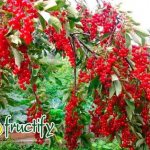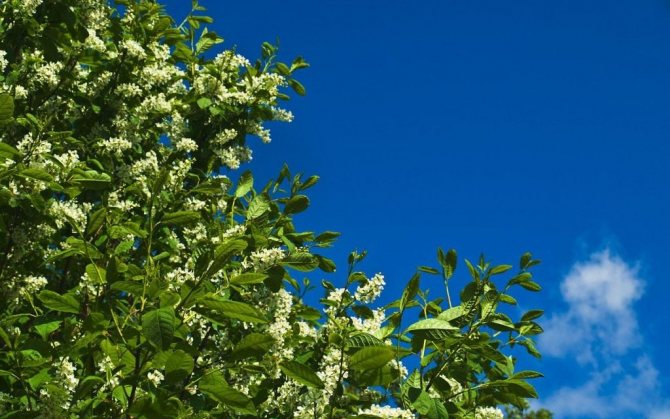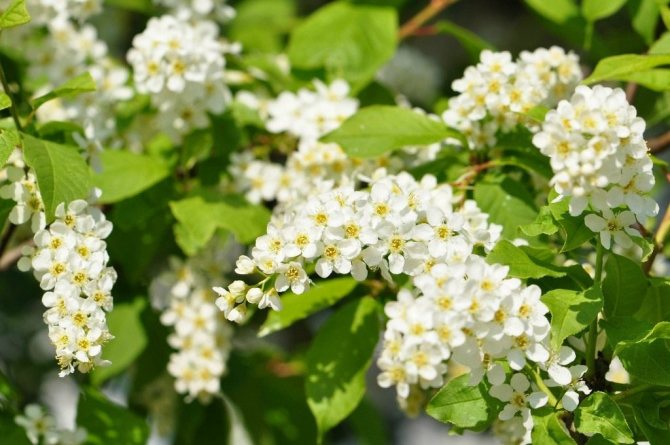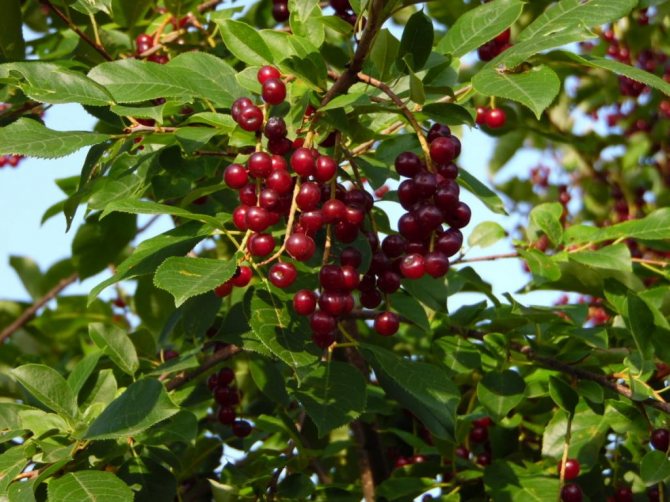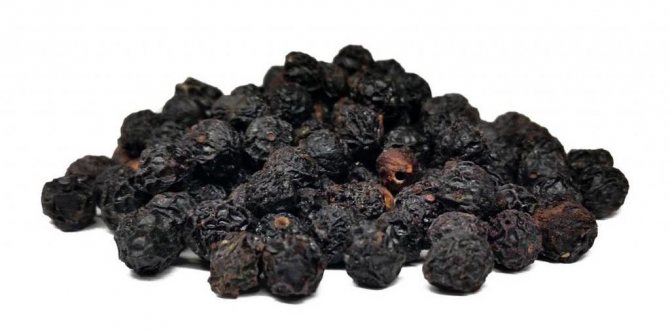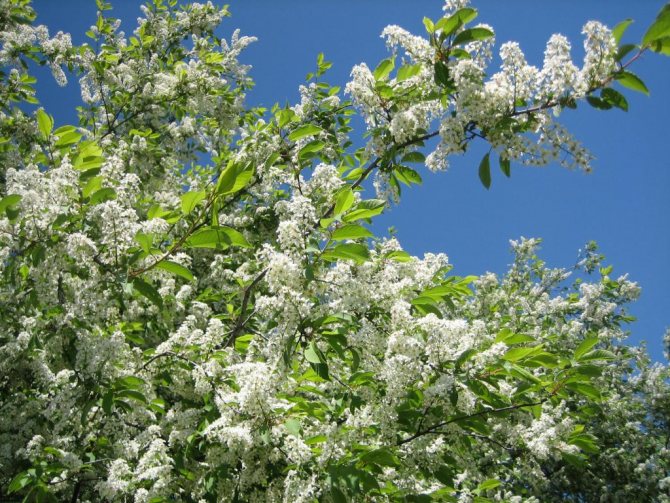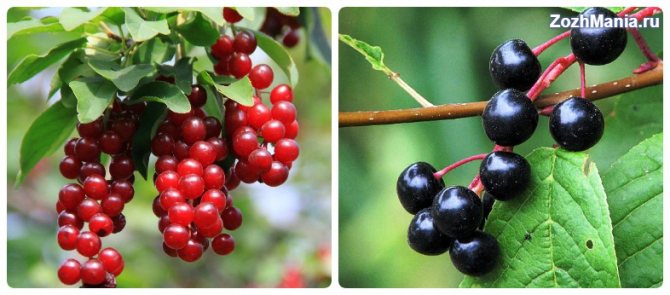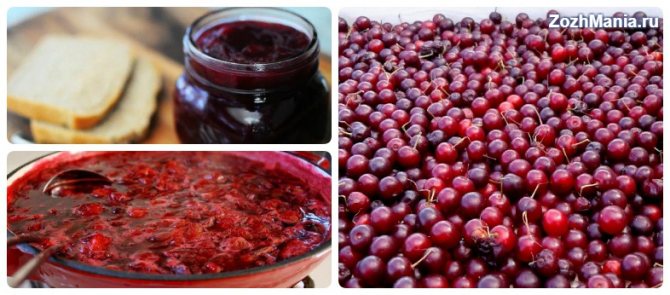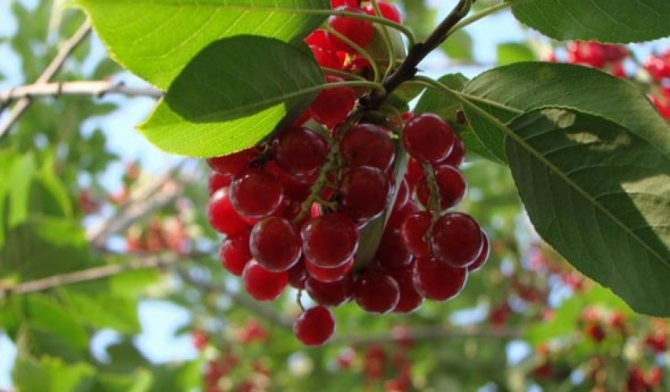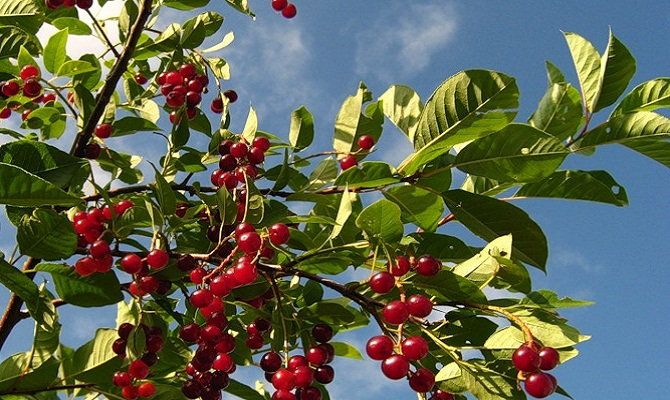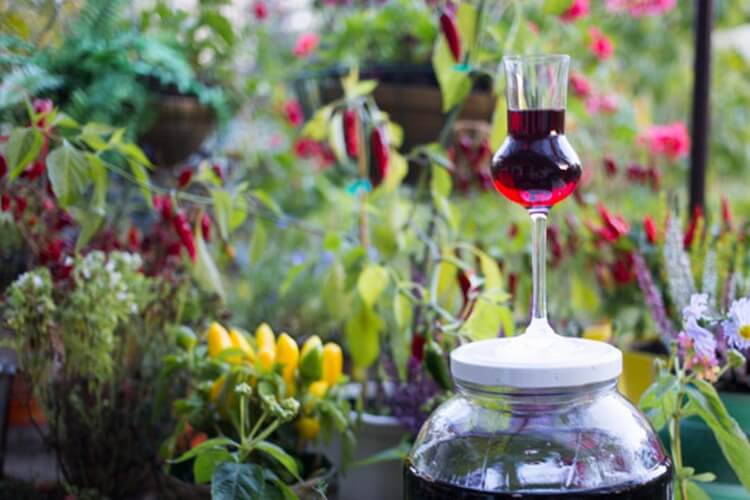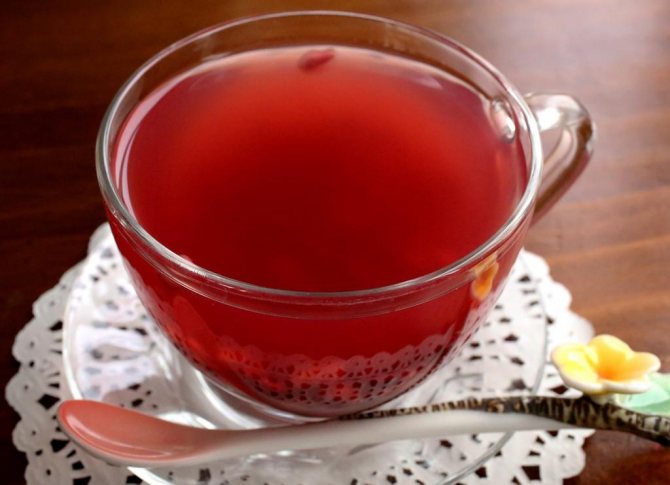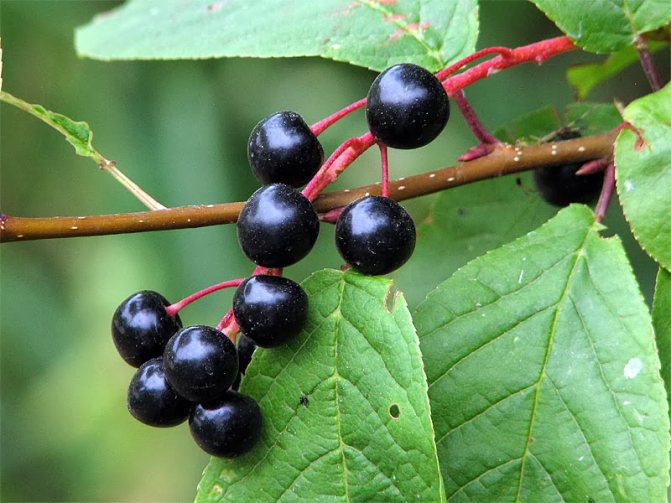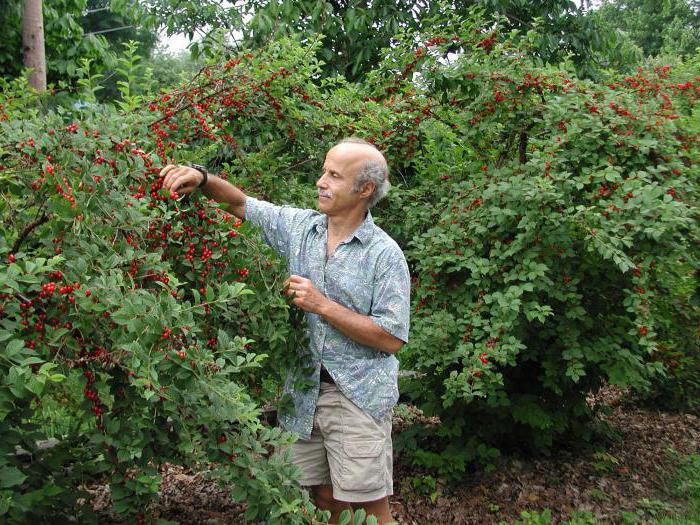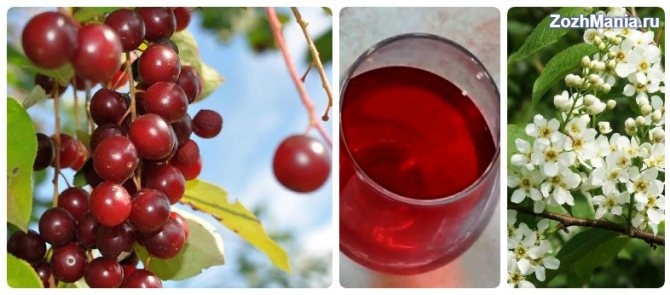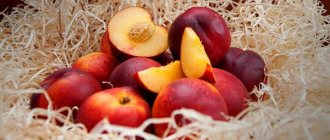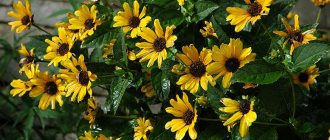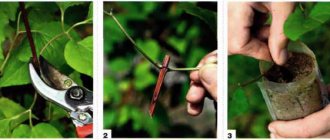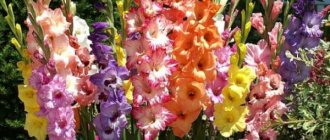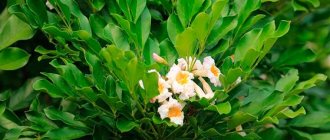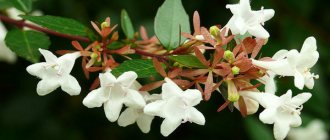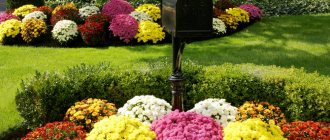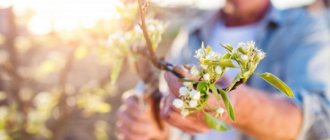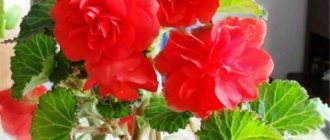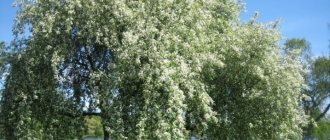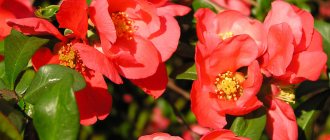Features of the variety
The common bird cherry, well known to us, can reach a height of 11 - 12 meters, while the virgin bird cherry looks more like a bush than a tree. It belongs to undersized varieties, although in favorable conditions it can grow up to 6 - 7 meters in height.
The leaves of the red-fruited bird cherry are ovoid, dark green in color, even young ones that have just appeared. The tree blooms in large clusters consisting of small white flowers. In comparison with the black-fruited variety, the inflorescences are larger, can reach 15 cm in length. The red bird cherry blossoms 2 weeks later than the black one, thanks to which it manages to protect the ovary from the May frosts, which are often observed in our latitudes. This fact makes the cultivation of red bird cherry especially attractive for gardeners. Late flowering allows the tree to produce a higher yield.
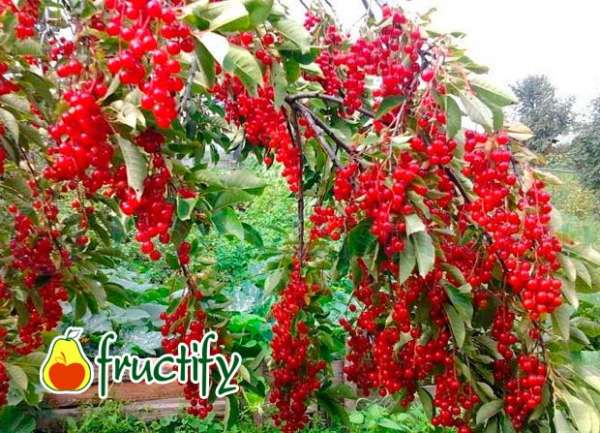
The red-fruited tree is especially beautiful in the fall months, when the foliage takes on a crimson hue and the berries are colored. This variety is often used for decorative purposes.
Having learned what a garden beauty looks like, many want to decorate their garden with this specimen. Having studied the photo and description of the plant, gardeners safely plant red bird cherry on their plots. Planting and caring for it is simple:
- the plant needs space, since it has a spreading crown and quickly forms root shoots;
- he likes loose, well-moistened soils;
- the plant is able to withstand severe frosts;
- planting is carried out in autumn or spring, cuttings are deepened by 40 - 50 cm into the ground;
- superphosphate is added as a fertilizer when planting in a pit;
- to increase yields, several trees of the same variety should be planted next to each other at a distance of about 2 m to ensure their good pollination;
- the tree feels good both in the sun and in the shade, but the presence of sunlight is important for harvesting;
- red bird cherry is resistant to pests, but aphids often settle on it;
- due to the rapid growth of root growth, it is better to outline the space for plant growth with the help of a dense barrier, deepened 35 - 40 cm into the ground;
- it is periodically recommended to carry out formative and sanitary pruning of branches, but it is worth knowing that the fruits are tied on last year's growth;
- reproduction of the plant is possible both by cuttings and root shoots, and by seeds.
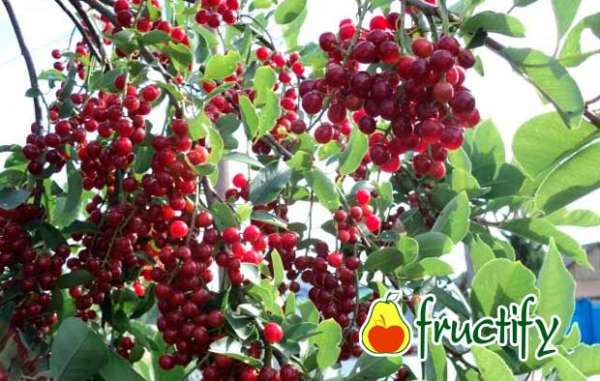

Note: in the countries of North America, where the Virginia bird cherry grows everywhere, the tree is most often found on the banks of rivers, the soils of which are rich in moisture.
The tree requires minimal care and attention, and it yields much more than the usual chokeberry. Moreover, bird cherry with scarlet berries is more appreciated for the taste of the fruit. Red berries contain 9 to 13% sugars, while black berries contain about 5%. Because of this, the taste of red berries is sweeter. In addition, the red fruits are not so tart. They contain about 1% tannins, while in common bird cherry their concentration is almost 10 times higher.
Species characteristic
Bird cherry Colorata is a tall tree (5-6 meters) with a dense, ovoid crown. The bark and shoots of the tree are colored in an unusual purple color, with both light and dark shades present.Young leaves are similar in color to shoots, and at a more mature age they become bronze-green.
The inflorescences are usually collected in clusters. The flowers of the bird cherry are very beautiful and fragrant, painted in a light pink color. It is thanks to them that culture is used in landscape design to create various compositions.
The berries of the Colorata bird cherry are edible, have a pleasant, tart taste, when mature they are painted black, the skin of the fruit is shiny, glossy.
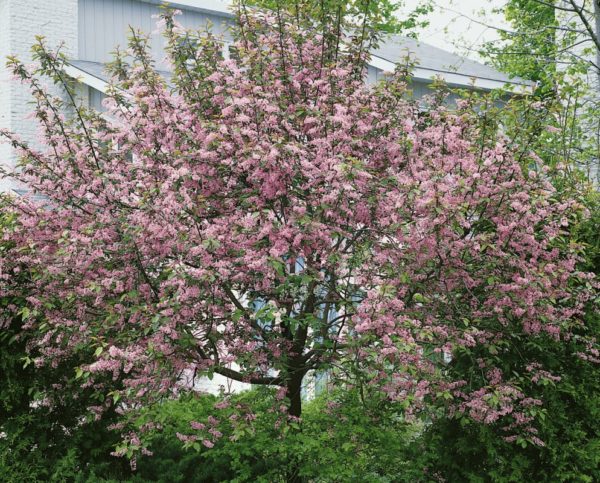

Blooming bird cherry Kolorata at their summer cottage
Vitamin and mineral composition of berries
To understand whether the red bird cherry is useful, it is worth considering its vitamin and mineral composition. The fruits contain:
- vitamin C - an immunostimulant, increases the body's resistance to viruses and bacteria, accelerates the healing process in case of a cold;
- vitamin P - refers to flavonoids, normalizes blood pressure, regulates heart rate, stimulates the activity of the adrenal cortex;
- magnesium - ensures the normal functioning of the nervous system, prevents jumps in blood sugar levels, helps muscles recover faster after exertion;
- iron - participates in the provision of oxygen to the tissues of the body, it is necessary for the normal growth of the body, supports the functioning of the thyroid gland, improves the functioning of the brain;
- cobalt - participates in protein metabolism, is necessary for DNA synthesis, stimulates the growth and development of erythrocytes, improving blood composition;
Calorie content and influence on the figure
The calorie content of fresh red bird cherry is slightly higher than black, due to the higher sugar content. In 100 g of berries, about 50 kcal. But still, this is a low indicator, which allows the berry to be classified as a dietary product. When eating fresh fruits, there will be no harm to the figure, especially if we take into account the fact that we are not used to eating bird cherry in handfuls.
Dried bird cherry will be much more nutritious. Drying is one of the most popular ways of harvesting fruits for the winter, as it allows you to preserve the nutrients from the bird cherry composition for a long period. Dried berries are used not only in cooking, but also in folk medicine. When dried, about 80% of the water leaves the berry, so its calorie content rises to 270 kcal.
Red cherry jam and other berry delicacies, which contain sugar, will be even more nutritious. The calorie content of bird cherry jam can be 280 - 300 kcal, depending on the amount of sugar in the recipe. Red cherry jam has a pleasant taste and texture, but those who follow the figure should use it in small portions, up to 50 g per day.
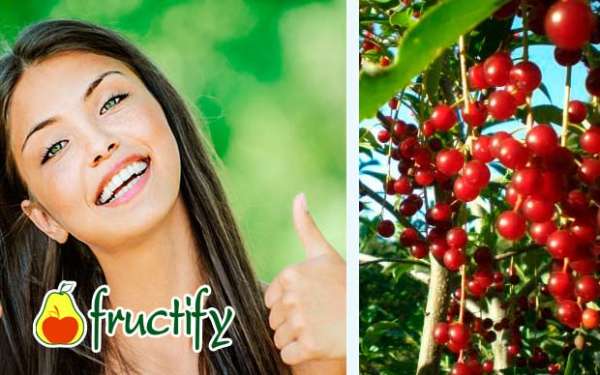

Note: Unlike dried berries, canned jam is not as good for your health. Heat treatment destroys many vitamins and active substances.
Tree care
Immediately after planting, it is necessary to cut the tree so that its height is 60-70 centimeters, and remove all lateral branches, leaving the 4 most developed shoots. This procedure will have a beneficial effect on the formation of the bird cherry crown. Next year, in this way, it will be necessary to form the second tier, then the third, etc.
In the first month after planting a seedling with an open root system, it must be thoroughly watered.
Bird cherry Colorata tolerates drought well, but timely application of moisture will help improve the health of the tree.
A mandatory procedure is regular loosening of the near-trunk circle and removal of weeds.
In order to avoid the development of diseases and the multiplication of bacteria in early spring (immediately after the snow melts) and in late autumn (after leaf fall), sanitary pruning is carried out. During this procedure, dry, frozen or affected branches are removed. In adulthood, thinning pruning should be carried out.It is also necessary to carefully monitor the direction of growth of the shoots and cut off the branches growing inside the crown in time.
The benefits of red cherry
Red bird cherry is a unique plant widely used in folk medicine. Moreover, folk healers and herbalists use not only fruits, but also the bark, leaves and flowers of bird cherry. Here are some pros for those who are thinking of planting a tree on their site:
- red bird cherry helps to eliminate diarrhea in case of indigestion, poisoning, intestinal infections;
- the bark of the tree has a pronounced diuretic and diaphoretic effect, which makes it possible to use it as a means to normalize body temperature in case of fever and to eliminate edema;
- fruits strengthen the walls of blood vessels, improve heart function, protect against the development of cardiovascular diseases;
- the bactericidal and anti-inflammatory property of berries and leaves allows the use of decoctions from them to treat inflammation of the gums and oral mucosa, throat diseases;
- the ability to liquefy and remove phlegm from the lungs makes red bird cherry berries and their decoctions an effective cough medicine.
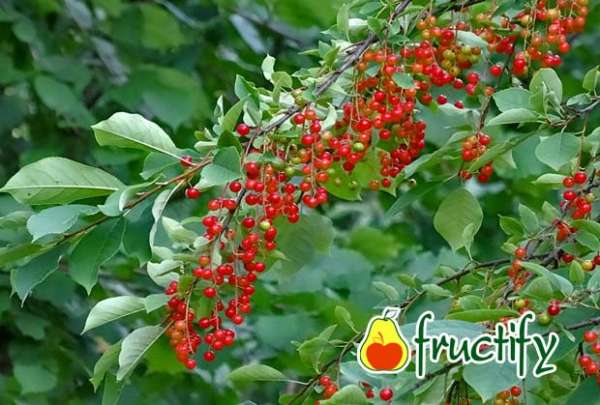

Red bird cherry for men
Speaking about the benefits of red berries for men, it is worth noting the ability of the fruit to increase male strength. Improving blood circulation, which occurs with regular use of the product, has a positive effect on potency. The berry enhances libido, it can be used as an aphrodisiac.
Indications for use
Unlike other plants, bird cherry has a number of contraindications due to the presence in its composition of the glycoside amygdalin, which, when broken down, forms hydrocyanic acid, which is harmful to health. So, drugs based on it are contraindicated:
- people prone to allergies to herbal ingredients;
- people prone to constipation;
- children under 2 years of age;
- people with type 2 diabetes.
Bird cherry has been noticed in the culinary art for a long time. Basically, specific parts of the plant are used in folk medicine, but culinary preferences give its fruits.
Most often they go to the preparation of juices, compotes, liqueurs, canned food, snacks.
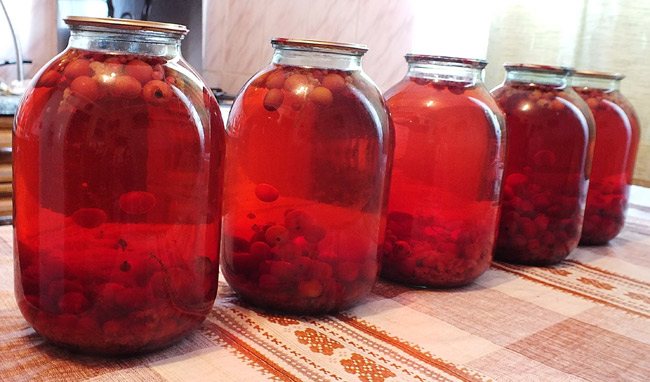

Fresh and canned fruits are used in the preparation of cakes, pies and rolls. Dried and harvested fruits for the winter are used as an aromatic component of flour intended for baking bakery products.
Like any herbal remedy used in treatment, bird cherry has some contraindications for use.
- pregnancy and breastfeeding;
- children under 2 years old;
- chronic constipation and the presence of hemorrhoids.
Attention. When eating bird cherry fruits, a certain measure must be observed. Too many berries consumed at one time can cause constipation in a healthy person.
Bird cherry - a real pantry of useful substances. Perfectly helps in the fight against various ailments, as well as in the general strengthening of the body. But, in order not to harm yourself, it is necessary to observe certain measures when using it, then the healing power of this plant will only benefit the body.
- Dysentery.
- Diseases of the stomach. Gastroenteritis (acute and chronic course).
- Rheumatism, arthritis, gout.
- Migraine headaches.
- Elevated temperature. Fever.
- Diarrhea.
- Inflammation of the small and large intestine.
- Pain symptoms in diseases of the joints.
- Toothache. Caries.
- Heart disease.
- Furunculosis, dermatosis, purulent wounds, bedsores.
- Psoriasis, scabies, acne.
- Koch's wand.
- Conjunctivitis, blepharitis.
- Colpitis, venereal diseases.
- Toxicosis.
Like all medicines, preparations that include bird cherry also have restrictions in their use and require a serious attitude towards themselves.
Bird cherry is a poisonous plant as it contains amygdalin, which is found in all parts of the tree.The decomposition product of this substance is hydrocyanic acid. That is why berry preparations are prepared from whole dried fruits.
Bird cherry berries have strong bonding properties that can lead to constipation. It is also a contraceptive - therefore, it affects the reproductive function of the female body.


Reception for pregnant women is contraindicated, since there is a risk of miscarriage in the first trimester. The scent of flowers can have a negative effect on the posture process. It is recommended to temporarily abandon the bouquets of cherry flowers in the house.
It is not recommended to give berries to young children. Unripe fruits can cause food poisoning.
Important! With long-term storage of medicines, a poison, hydrocyanic acid, is released from the berries and bark. Long-term storage is hazardous to health.
The benefits of leaves, flowers and bark of red bird cherry
Useful properties are possessed not only by the fruits, but also by all other parts of the plant:
- the bark of red bird cherry contains tannins, which have an astringent effect, relieve inflammation, phytoncides in its composition are effective in the treatment of diseases of the heart and blood vessels, bronchopulmonary diseases;
- bird cherry leaves contain substances that can cure gout, eliminate anemia;
- flowers are a powerful source of phytoncides, during flowering bird cherry disinfects the air around itself, repels pests, kills viruses and bacteria.
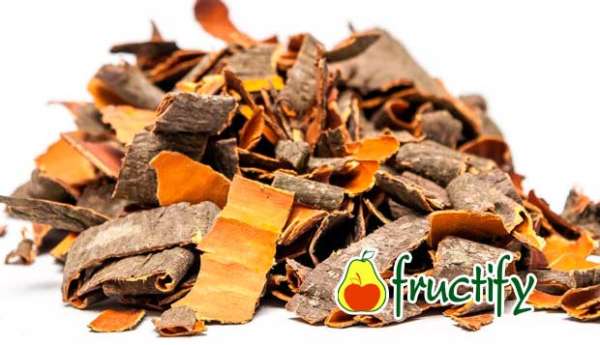

Decoctions and infusions recipes
Recipes for healing broths and infusions based on bird cherry have been passed on by fans of traditional medicine over the decades. The effectiveness of these funds is often inferior to pharmacy drugs, moreover, their recipe has changed several times, so before using them, you should consult a doctor:
- a decoction of bird cherry bark: a tablespoon of dried crushed bark is poured with 2 glasses of water, brought to a boil, kept on fire for 10 - 15 minutes, cooled, filtered;
- a decoction of the fruits of red bird cherry: pour 2 tablespoons of dried berries with a glass of boiling water, put in a water bath for 20 - 25 minutes, filter through cheesecloth, add boiled water to the broth to bring the volume of the product to 250 ml;
- infusion of leaves and fruits: 1 tablespoon of dried crushed leaves and 1 tablespoon of dry berries are poured with 0.5 liters of boiling water, insisted for about an hour (it is convenient to use a thermos to prepare the infusion).
Important! Broths and infusions of berries and bird cherry bark due to the content of amygdalin in them should be drunk on the day of preparation. A fresh drink is prepared the next day.
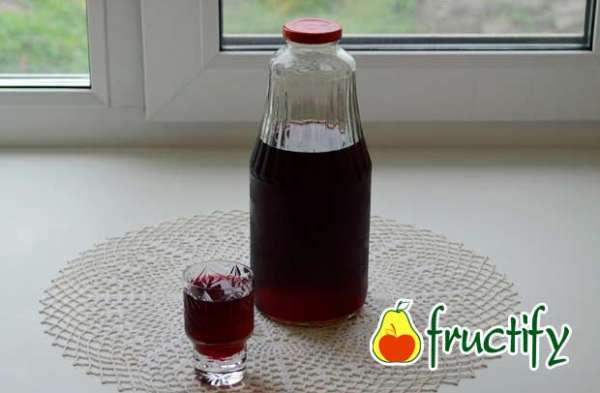

Procurement and storage of raw materials
You can save the benefits of the fruits, bark, flowers and leaves of red bird cherry by properly harvesting plant materials. Drying is considered the best way to do this. For drying, you can use special electric dryers that maintain a temperature of 55 - 60 degrees, or ovens. Drying in natural conditions is also possible, but this process will be more time-consuming and laborious.
Possible harm and contraindications
Bird cherry is a berry from which both benefits and harm are possible. This is due to the content of amygdalin glycoside in the fruit seeds. On contact with gastric juice, amygdalin turns into hydrocyanic acid. Eating pitted red bird cherry can lead to severe poisoning. You can not swallow the bones, bite them, and when using the fruit in cooking, the bones should be thrown away.
Note: it is believed that when preserving bird cherry berries with seeds, the harmful properties of amygdalin begin to manifest themselves a year after the start of canned food storage. It is recommended to eat bird cherry jam in the first six months from the moment of preparation of the workpiece. But it is much safer to still separate the bones from the pulp and not add them to the product during conservation.
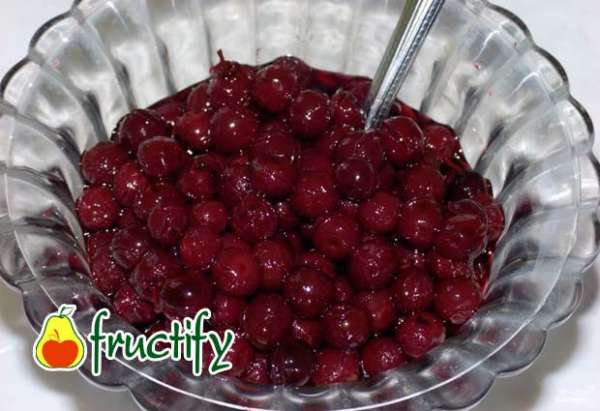

The number of bird cherry seeds that can provoke poisoning is difficult to name.Experienced people assure that even a handful of berries, eaten together with seeds, cannot lead to amygdalin poisoning. But livestock should be grazed away from the places where the bird cherry grows, since the animal can eat too many leaves and get poisoned.
Contraindications to the use of bird cherry also include:
- a tendency to constipation;
- children's age up to 3 years;
- individual intolerance;
- allergy;
- pregnancy and lactation.
Landing rules
As a rule, planting bird cherry is not difficult even for novice gardeners. To get a highly decorative and healthy plant with medicinal properties, it is enough to adhere to a simple technology:
- Bird cherry is very sun-loving, but it is quite easy to take root in areas with some shading.
- For the full development of the root system and crown of the plant, sufficient space is required.
- Planting several bird cherry plants nearby will ensure their cross-pollination.
- The standard distance between plants when planting is 4.5–5.0 m.
- A small amount of mineral and organic fertilizers is poured into the planting pit along with the fertile soil. If there is a lot of organic matter, the plant may die.
Red bird cherry in cooking
Red bird cherry is used in cooking more actively than black... Its taste is sweeter and has no pronounced astringency, and the size of the fruit is larger. Berries are used for cooking jams, compotes, jelly.
They are dried and then used in various dishes or eaten as raisins. The dried fruit can be ground in a coffee grinder or food processor and used as flour. It is added to baked goods, used to thicken sauces. Bird cherry flour is very aromatic and gluten free, making it a valuable product for people suffering from gluten intolerance.
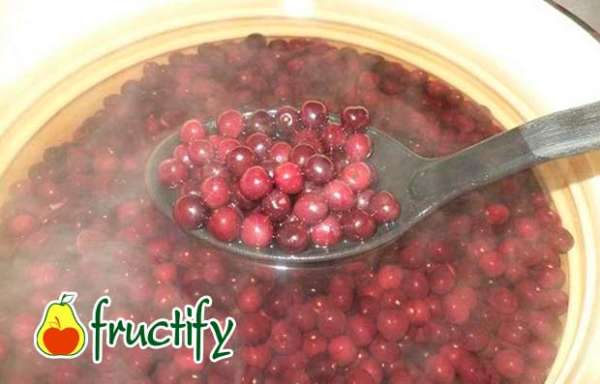

To prepare jam, jam, jelly and other dishes and drinks, the seeds should be removed from the bird cherry. To do this quickly, use a metal sieve. The fruits are washed and then rubbed through a sieve. The second way is to blanch the berries by boiling them for about 3 minutes in boiling water, and then grind them through a sieve. After boiling the berries in water, the pulp separates from the seeds more easily, but this method is not suitable for all dishes.
Procurement of raw materials
Red bird cherry needs proper preparation to preserve all useful elements. On a sunny day, ripe fruits are plucked with brushes. If you pick only berries, they will very quickly turn into a shapeless, useless slurry.
The prepared raw materials are dried in a dryer or oven at a temperature of 400 degrees. The already processed berries are separated from the branches and leaves, as a result, a finished product is obtained in the form of round shriveled dried fruits, which have a sour taste and do not smell. You can store such fruits for two years, after which they lose their healing properties.
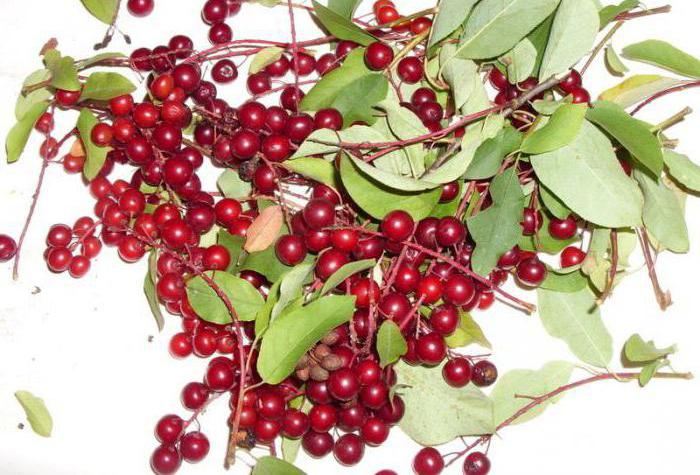

The bark harvested in early spring is processed in a similar way. It saves its useful components for five years.
Flowers are easiest to dry. For this purpose, they are placed on a flat, dry surface and left in a place with dark lighting and low humidity. The product is stored for one year.

